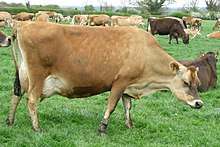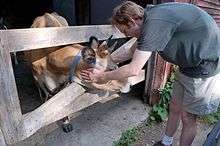Jersey cattle
 A Jersey cow in England. | |
| Country of origin | Jersey |
|---|---|
| Use | Dairy |
| Traits | |
| Weight |
|
| Coat | Fawn |
| |
The Jersey is a breed of small dairy cattle. Originally bred in the Channel Island of Jersey, the breed is popular for the high butterfat content of its milk and the lower maintenance costs attending its lower bodyweight, as well as its genial disposition. The Jersey is one of three Channel Island cattle breeds, the others being the Alderney – now extinct – and the Guernsey.
The Jersey cow ranges from only 400–500 kilograms (880–1,100 lb). The main factor contributing to the popularity of the breed has been their greater economy of production, due to:
- The ability to carry a larger number of effective milking cows per unit area due to lower body weight, hence lower maintenance requirements, and superior grazing ability
- Calving ease and a relatively lower rate of dystocia, leading to their popularity in crossbreeding with other dairy and even beef breeds to reduce calving related injuries.
- High fertility.
- High butterfat conditions, 4.84% butterfat and 3.95% protein, and the ability to thrive on locally produced food.[1] Bulls are also small, ranging from 540 to 820 kg (1200 to 1800 pounds), and are notoriously aggressive.
Castrated males can be trained into fine oxen which, due to their small size and gentle nature, make them popular with young teamsters. Jersey oxen are not as strong as larger breeds however and are generally out of favour among competitive teamsters.
Due to the small size, docile and inquisitive character and attractive features of the Jersey cow, small herds were imported into England by aristocratic landowners as adornment for aesthetically landscaped parks.
Jerseys come in all shades of brown, from light tan to almost black. They are frequently fawn in colour. All purebred Jerseys have a lighter band around their muzzle, a dark switch (long hair on the end of the tail), and black hooves, although in recent years colour regulations have been relaxed to allow a broadening of the gene pool.
The cows are calm and docile animals, but tend to be a little more nervous than other dairy cow breeds. The cows are also highly recommended cows for first time owners and marginal pasture. Jersey bulls are another matter. While all dairy bulls are considered dangerous animals, Jersey bulls are considered by many to be the least docile of the dairy breeds.[2]
Jersey cattle have a greater tendency towards post-parturient hypocalcaemia (or "milk fever") in dams, and tend to have frail calves that require more attentive management in cold weather than other dairy breeds due to their smaller body size (which results in an increased surface area to mass ratio, increasing heat loss).
History of the breed

As its name implies, the Jersey was bred on the British Channel Island of Jersey. It apparently descended from cattle stock brought over from the nearby Norman mainland, and was first recorded as a separate breed around 1700.
The breed was isolated from outside influence for over two hundred years, from 1789 to 2008.
Before 1789 cows would be given as dowry for inter-island marriages between Jersey and Guernsey.[3] This was, however, not widespread.
In 1789, imports of foreign cattle into Jersey were forbidden by law to maintain the purity of the breed, although exports of cattle and semen have been an important economic resource for the island. The restriction on the import of cattle was initially introduced in 1789 to prevent a collapse in the export price. The United Kingdom levied no import duty on cattle imported from Jersey. Cattle were being shipped from France to Jersey and then being shipped onward to England to circumvent the tariff on French cattle. The increase in the supply of cattle, sometimes of inferior quality, was bringing the price down and damaging the reputation of Jersey cattle. The import ban stabilised the price and enabled a more scientifically controlled programme of breeding to be undertaken.

Sir John Le Couteur studied selective breeding and became a Fellow of the Royal Society – his work led to the establishment of the Royal Jersey Agricultural and Horticultural Society in 1833. At that time, the breed displayed greater variation than it does today with white, dark brown and mulberry beasts. However, since the honey-brown cows sold best the breed was developed accordingly. In 1860 1,138 cows were exported via England, the average price being £16 per head. By 1910 over a thousand head were exported annually to the United States alone. It is now the fastest growing dairy breed in the world.
On 1866, at the Annual General Meeting of the Royal Jersey Agricultural and Horticultural Society, H.G. Shepard notes in his history[4] that "it was resolved – on the motion of Col. Le Couteur, that the Hon. Secretary be hereby invited to open and to carry on a "herd book" in which the pedigree of bulls, cows and heifers shall be entered for reference to all the members of the Society." In 1869 for the first time prizes were awarded at the Society's Shows for Herd Book Stock Cattle.
The States of Jersey took a census of stock in 1866, and Jersey then supported 12,037 head of cattle, of which 611 were bulls, and no fewer than 6,322 pigs and 517 sheep. This was before the motor age and 3,227 horses were kept, Saint Helier being responsible for 888.
In July 2008, the States of Jersey took the historic step of ending the ban on imports, and allowing the import of bull semen from any breed of cattle, although only semen that is genetically pure will enable the resultant progeny to be entered in the Jersey Herd Book. For many decades each of the 12 parishes in Jersey would hold cattle shows in the Spring, Summer and Autumn of every year; followed in turn by the main shows held by the Royal Jersey Agricultural & Horticultural Society where the best of the parish shows would compete. It was said that the colour of the rosette secured by a prize-winning cow determined its export value. Today the RJAHS holds two shows a year where usually 5 or 6 of the remaining 23 herds will compete against each other for the top prizes. A Jersey cattle show is also held in Jersey, by The West Show Association.[5]
In February 2010, it was revealed that semen from a non-pure breed Jersey bull had been imported into the island despite strict laws and checks, and 100 cows have been impregnated with the semen. Their offspring will not be recorded in the Jersey herd book.[6]
Jersey cattle were exported to the United States from about 1850. A breed society, the American Jersey Cattle Club, was formed in 1868. In the USA, a distinction is sometimes made between the "American Jersey", which is comparatively coarse and large and has been selectively bred mainly for milk yield, and the original or "Island" type;[7]:212 the latter may also be called "Miniature Jersey".[8][9]
Famous Jersey cows
- Brown Bessie, the famous champion butter cow of the Chicago World's Fair dairy test, averaged over 18 kg (40 pounds) of milk a day for five months, and made 1.3 kg ( 3Lb ) of butter a day.[10]
- Huronia Centurion Veronica 20J EX-97% is a well known show cow of the Jersey breed. In 2003 she was sold for $85,000 at public auction. She was the 2006 World Dairy Expo Supreme Champion.[11] She has also been named the All-American Grand Champion Jersey.[12]
- Mainstream Barkley Jubilee holds the top two records for milk production for a Jersey cow. She produced 49,250 lbs of milk after calving at 3 years and 6 months of age, and 55,590 lbs after calving at 4 years and 8 months old.[13]
- Lily Flagg, raised in Northeast Huntsville, Alabama, champion butterfat and milk producer of 1892. She produced a record 1047 pounds, 3/4 ounces of butter as well as 11,339 pounds of milk.[14] Her owner threw a locally famous high-class party in her honour, going so far as to paint his house "butter yellow" for the occasion.[15] She was a "Cow worth Kissing", her value to the community was so high.[16]
See also
References
- ↑ Rex Paterson in Jersey Cattle, ed. Boston, 1954, pp81-95
- ↑ "Breeds of Livestock – Jersey Cattle — Breeds of Livestock, Department of Animal Science". www.ansi.okstate.edu. Retrieved 31 March 2018.
- ↑ Jersey Cattle, Eric James Boston. 1954.
- ↑ One Hundred Years of the Royal Jersey Agricultural and Horticultural Society 1833–1933. Compiled from the Society's Records, by H.G. Shepard, Secretary
- ↑ "Jersey Cattle Show & Family Day Out – The West Show, Jersey". Westshow.org.je. 8 July 2012. Retrieved 25 February 2013.
- ↑ "Non-pure bull semen imported into Jersey". BBC News. 17 February 2010. Retrieved 25 February 2013.
- ↑ Valerie Porter, Lawrence Alderson, Stephen J.G. Hall, D. Phillip Sponenberg (2016). Mason's World Encyclopedia of Livestock Breeds and Breeding (sixth edition). Wallingford: CABI. ISBN 9781780647944.
- ↑ Miniature Jersey Breed History. American Miniature Jersey Registry & Association. Accessed January 2018.
- ↑ History of the magnificent Jersey breed. Miniature Jersey Herd Book. Accessed January 2018.
- ↑ "The Book of the Fair : Chapter the Nineteenth: The Live-Stock Department (Image)/ Paul V. Galvin Digital History Collection". Columbus.gl.iit.edu. 26 August 1998. Retrieved 25 February 2013.
- ↑ "Show Summaries 2006". World Dairy Expo. Retrieved 6 March 2016.
- ↑ "Dairy Cow Daily – Huronia Centurion Veronica 20J". www.dairycowdaily.com. Retrieved 6 March 2016.
- ↑
- ↑ Lucindaville (17 April 2010). "Cookbook Of The Day: Huntsville Heritage Cookbook". Cookbookoftheday.blogspot.com. Retrieved 25 February 2013.
- ↑ "Huntsville History Comes Alive". Huntsville.about.com. 9 April 2012. Retrieved 25 February 2013.
- ↑ http://historyconnections.info/hh/hhpics/pdf/hhq1/HHQ-Vol-XV-3-Spr-89.pdf
- 1 2 "Rapid Bay Jerseys". www.rapidbay.ca. Retrieved 6 March 2016.
- ↑ Sydney L. Spahr, George E. Opperman (1995). The Dairy Cow Today: U.S. Trends, Breeding, and Progress Since 1980. USA: Hoard's Dairyman. p. 74.
- Balleine's History of Jersey, Marguerite Syvret and Joan Stevens (1998) ISBN 1-86077-065-7
- Butterfat in Relation to the Jersey Breed, Boston, E.J. and H.L. Webb, WJCB, 1954.
- A Short History on the Origins of Jersey Cattle., Boston Eric, WJCB 1965
External links
| Wikimedia Commons has media related to Jersey cattle. |